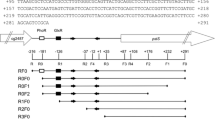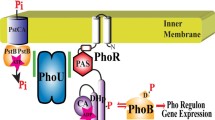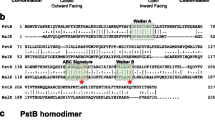Abstract
The Arc two-component signal transduction system of Escherichia coli comprises the ArcB sensor kinase and the ArcA response regulator. Under anoxic growth conditions, ArcB autophosphorylates and transphos-phorylates ArcA, which, in turn, represses or activates its target operons. ArcA has been shown to be able to autophosphorylate in vitro at the expense of acetyl-P. Here, the in vivo effect of acetyl phosphate on the redox signal transduction by the Arc system was assessed. Our results indicate that acetyl phosphate can modulate the expression of ArcA-P target genes only in the absence of ArcB. Therefore, the acetyl phosphate dependent ArcA phosphorylation route does not seem to play a significant role under physiological conditions.
Similar content being viewed by others
References
Bohannon, D.E., N. Connell, J. Keener, A. Tormo, M. Espinosa-Urgel, M.M. Zambrano, and R. Kolter. 1991. Stationary-phaseinducible “gearbox” promoters: Differential effects of katF mutations and role of σ70. J. Bacteriol. 173, 4482–4492.
Bouché, S., E. Klauck, D. Fischer, M. Lucassen, K. Jung, and R. Hengge-Aronis. 1998. Regulation of RssB-dependent proteolysis in Escherichia coli: a role for acetyl phosphate in a response regulator-controlled process. Mol. Microbiol. 27, 787–795.
Chamnongpol, S. and E.A. Groisman. 2000. Acetyl phosphate-dependent activation of a mutant PhoP response regulator that functions independently of its cognate sensor kinase. J. Mol. Biol. 300, 291–305.
Dailey, F.E. and H.C. Berg. 1993. Change in direction of flagellar rotation in Escherichia coli mediated by acetate kinase. J. Bacteriol. 175, 3236–3239.
Deretic, V., J.H.J. Leveau, C.D. Mohr, and N.S. Hibler. 1992. In vitro phosphorylation of AlgR, a regulator of mucoidy in Pseudomonas aeruginosa, by a histidine protein kinase and effects of small phospho-donor molecules. Mol. Microbiol. 6, 2761–2767.
Drapal, N. and G. Sawers. 1995. Purification of ArcA and analysis of its specific interaction with the pfl promoter-regulatory region. Mol. Microbiol. 16, 597–607.
Feng, J., M.R. Atkinson, W. McCleary, J.B. Stock, B.L. Wanner, and A.J. Ninfa. 1992. Role of phosphorylated metabolic intermediates in the regulation of glutamine synthetase synthesis in Escherichia coli. J. Bacteriol. 174, 6061–6070.
Fredericks, C.E., S. Shibata, S.I. Aizawa, S.A. Reimann, and A.J. Wolfe. 2006. Acetyl phosphate-sensitive regulation of flagellar biogenesis and capsular biosynthesis depends on the Rcs phosphorelay. Mol. Microbiol. 61, 734–747.
Georgellis, D., O. Kwon, and E.C. Lin. 1999. Amplification of signaling activity of the arc two-component system of Escherichia coli by anaerobic metabolites — An in vitro study with different protein modules. J. Biol. Chem. 274, 35950–35954.
Georgellis, D., O. Kwon, and E.C.C. Lin. 2001a. Quinones as the redox signal for the Arc two-component system of bacteria. Science 292, 2314–2316.
Georgellis, D., O. Kwon, E.C. Lin, S.M. Wong, and B.J. Akerley. 2001b. Redox signal transduction by the ArcB sensor kinase of Haemophilus influenzae lacking the PAS domain. J. Bacteriol. 183, 7206–7212.
Georgellis, D., O. Kwon, P. De Wulf, and E.C.C. Lin. 1998. Signal decay through a reverse phosphorelay in the arc two-component signal transduction system. J. Biol. Chem. 273, 32864–32869.
Georgellis, D., A.S. Lynch, and E.C. Lin. 1997. In vitro phosphorylation study of the arc two-component signal transduction system of Escherichia coli. J. Bacteriol. 179, 5429–5435.
Head, C.G., A. Tardy, and L.J. Kenney. 1998. Relative binding affinities of OmpR and OmpR-phosphate at the ompF and ompC regulatory sites. J. Mol. Biol. 281, 857–870.
Hiratsu, K., K. Makino, A. Nakata, and H. Shinagawa. 1995. Autophosphorylation and activation of transcriptional activator PhoB of Escherichia coli by acetyl phosphate in vitro. Gene 161, 7–10.
Hoch, J.A. 1995. Control of cellular development in sporulating bacteria by the phosphorelay two-component signal transduction system, p. 129–144. In J.A. Hoch and T.J. Silhavy (eds.), Two-component signal transduction. ASM Press, Washington, D.C., USA.
Holman, T.R., Z. Wu, B.L. Wanner, and C.T. Walsh. 1994. Identification of the DNA-binding site for the phosphorylated VanR protein required for vancomycin resistance in Enterococcus faecium. Biochemistry 33, 4625–4631.
Hyede, M., P. Laloi, and R. Portalier. 2000. Involvement of carbon source and acetyl phosphate in the external pH-dependent expression of porin genes in Escherichia coli. J. Bacteriol. 182, 198–202.
Jung, W.S., Y.R. Jung, D.B. Oh, H.A. Kang, S.Y. Lee, M. Chavez-Canales, D. Georgellis, and O. Kwon. 2008. Characterization of the Arc two-component signal transduction system of the capnophilic rumen bacterium Mannheimia succiniciproducens. FEMS Microbiol. Lett. 284, 109–119.
Kim, S.K., M.R. Wilmes-Riesenberg, and B.L. Wanner. 1996. Involvement of the sensor kinase EnvZ in the in vivo activation of the response regulator PhoB by acetyl phosphate. Mol. Microbiol. 22, 135–147.
Klein, A.H., A. Shulla, S.A. Reimann, S.H. Keating, and A.J. Wolfe. 2007. The intracellular concentration of acetyl phosphate in Escherichia coli is sufficient for direct phosphorylation of two-component response regulators. J. Bacteriol. 189, 5574–5581.
Kwon, O., D. Georgellis, A.S. Lynch, D. Boyd, and E.C. Lin. 2000a. The ArcB sensor kinase of Escherichia coli: genetic exploration of the transmembrane region. J. Bacteriol. 182, 2960–2966.
Kwon, O., D. Georgellis, and E.C. Lin. 2000b. Phosphorelay as the sole physiological route of signal transmission by the arc two-component system of Escherichia coli. J. Bacteriol. 182, 3858–3862.
Kwon, O., D. Georgellis, and E.C. Lin. 2003. Rotational on-off switching of a hybrid membrane sensor kinase Tar-ArcB in Escherichia coli. J. Biol. Chem. 278, 13192–13195.
Lindqvist, A., J. Membrillo-Hernández, R.K. Poole, and G.M. Cook. 2000. Roles of respiratory oxidases in protecting Escherichia coli K12 from oxidative stress. Antonie Van Leeuwenhoek 78, 28–31.
Link, A.J., D. Phillips, and G.M. Church. 1997. Methods for generating precise deletions and insertions in the genome of wildtype Escherichia coli: application to open reading frame characterization. J. Bacteriol. 179, 6228–6237.
Liu, X. and P. De Wulf. 2004. Probing the ArcA-P modulon of Escherchia coli by whole genome transcriptional analysis and sequence recognition profiling. J. Biol. Chem. 279, 12588–12597.
Lukat, G.S., W.R. McCleary, A.M. Stock, and J.B. Stock. 1992. Phosphorylation of bacterial response regulator proteins by low molecular weight phospho-donors. Proc. Natl. Acad. Sci. USA 89, 718–722.
Lynch, A.S. and E.C.C. Lin. 1996. Transcriptional control mediated by the ArcA two-component response regulator protein of Escherichia coli: Characterization of DNA binding at target promoters. J. Bacteriol. 178, 6238–6249.
Magasanik, B. 1995. Historical perspective, p. 1–5. In J.A. Hoch and T.J. Silhavy (eds.), Two-component signal transduction. ASM Press, Washington, D.C., USA.
Malpica, R., B. Franco, C. Rodriguez, O. Kwon, and D. Georgellis. 2004. Identification of a quinone-sensitive redox switch in the ArcB sensor kinase. Proc. Natl. Acad. Sci. USA 101, 13318–13323.
Malpica, R., G.R. Sandoval, C. Rodriguez, B. Franco, and D. Georgellis. 2006. Signaling by the arc two-component system provides a link between the redox state of the quinone pool and gene expression. Antioxid. Redox Signal. 8, 781–795.
Matsubara, M. and T. Mizuno. 1999. EnvZ-independent phosphotransfer signaling pathway of the OmpR-mediated osmoregulatory expression of OmpC and OmpF in Escherichia coli. Biosci. Biotechnol. Biochem. 63, 408–414.
McCleary, W.R. 1996. The activation of PhoB by acetylphosphate. Mol. Microbiol. 20, 1155–1163.
McCleary, W.R. and J.B. Stock. 1994. Acetyl phosphate and the activation of two-component response regulators. J. Biol. Chem. 269, 31567–31572.
Miller, J. 1992. Experiments in molecular genetics. Cold Spring Harbor Laboratory, Cold Spring Harbor, New York, N.Y., USA.
Nyström, T., C. Larsson, and L. Gustafsson. 1996. Bacterial defense against aging: Role of the Escherichia coli ArcA regulator in gene expression, readjusted energy flux and survival during stasis. EMBO J. 15, 3219–3228.
Pena-Sandoval, G.R., O. Kwon, and D. Georgellis. 2005. Requirement of the receiver and phosphotransfer domains of ArcB for efficient dephosphorylation of phosphorylated ArcA in vivo. J. Bacteriol. 187, 3267–3272.
Prüß, B.M. and A.J. Wolfe. 1994. Regulation of acetyl phosphate synthesis and degradation, and control of flagellar expression in Escherichia coli. Mol. Microbiol. 12, 973–984.
Reyrat, J.M., M. David, C. Blonski, P. Boistard, and J. Batut. 1993. Oxygen-regulated in vitro transcription of Rhizobium meliloti nifA and fixK genes. J. Bacteriol. 175, 6867–6872.
Rodriguez, C., O. Kwon, and D. Georgellis. 2004. Effect of D-lactate on the physiological activity of the ArcB sensor kinase in Escherichia coli. J. Bacteriol. 186, 2085–2090.
Schröder, I., C.D. Wolin, R. Cavicchioli, and R.P. Gunsalus. 1994. Phosphorylation and dephosphorylation of the NarQ, NarX, and NarL proteins of the nitrate-dependent two-component regulatory system of Escherichia coli. J. Bacteriol. 176, 4985–4992.
Sevcik, M., A. Sebkova, J. Volf, and I. Rychlik. 2001. Transcription of arcA and rpoS during growth of Salmonella typhimurium under aerobic and microaerobic conditions. Microbiology 147, 701–708.
Shin, S. and C. Park. 1995. Modulation of flagellar expression in Escherichia coli by acetyl phosphate and the osmoregulator OmpR. J. Bacteriol. 177, 4696–4702.
Stock, J.B., M.G. Surette, M. Levit, and P. Park. 1995. Two-component signal transduction systems: structure-function relationships and mechanisms of catalysis, p. 25–51. In J.A. Hoch and T.J. Silhavy (eds.), Two-component signal transduction. ASM Press, Washington, D.C., USA.
Wanner, B.L. 1992. Is cross regulation by phosphorylation of two-component response regulator proteins important in bacteria? J. Bacteriol. 174, 2053–2058.
Wanner, B.L. and M.R. Wilmes-Riesenberg. 1992. Involvement of phosphotransacetylase, acetate kinase, and acetyl phosphate synthesis in the control of the phosphate regulon in Escherichia coli. J. Bacteriol. 174, 2124–2130.
Wolfe, A.J. 2005. The acetate switch. Microbiol. Mol. Biol. Rev. 69, 12–50.
Wolfe, A.J., D.E. Chang, J.D. Walker, J.E. Seitz-Partridge, M.D. Vidaurri, C.F. Lange, B.M. Pruss, M.C. Henk, J.C. Larkin, and T. Conway. 2003. Evidence that acetyl phosphate functions as a global signal during biofilm development. Mol. Microbiol. 48, 977–988.
Yu, D., H.M. Ellis, E.C. Lee, N.A. Jenkins, N.G. Copeland, and D.L. Court. 2000. An efficient recombination system for chromosome engineering in Escherichia coli. Proc. Natl. Acad. Sic. USA 97, 5978–5983.
Author information
Authors and Affiliations
Corresponding author
Rights and permissions
About this article
Cite this article
Liu, X., Peña Sandoval, G.R., Wanner, B.L. et al. Evidence against the physiological role of acetyl phosphate in the phosphorylation of the ArcA response regulator in Escherichia coli . J Microbiol. 47, 657–662 (2009). https://doi.org/10.1007/s12275-009-0087-9
Received:
Accepted:
Published:
Issue Date:
DOI: https://doi.org/10.1007/s12275-009-0087-9




